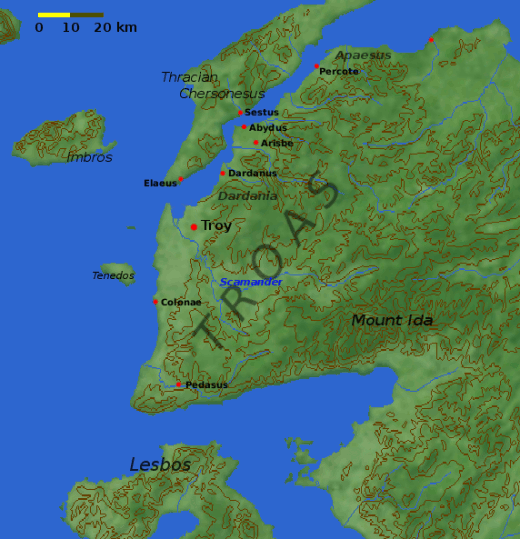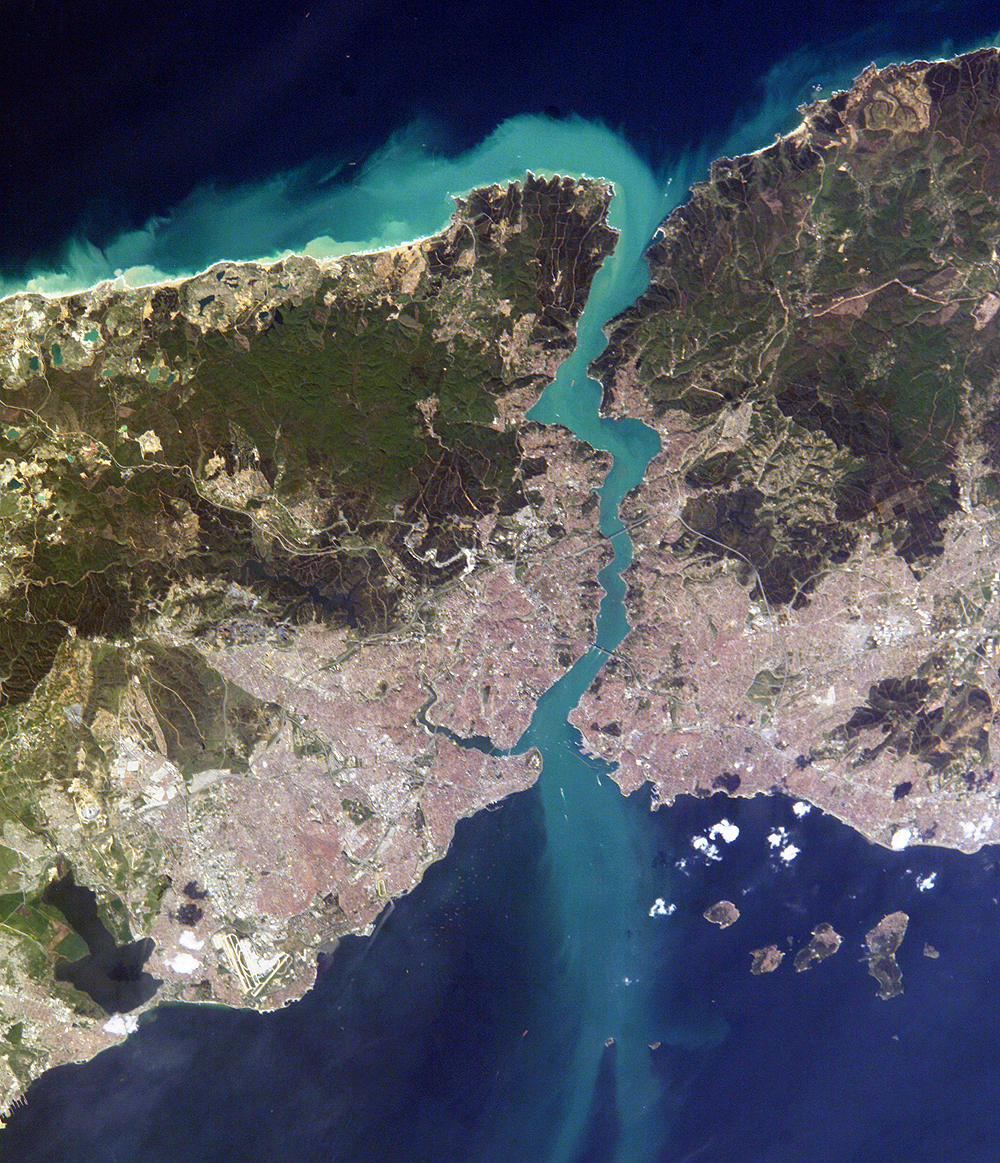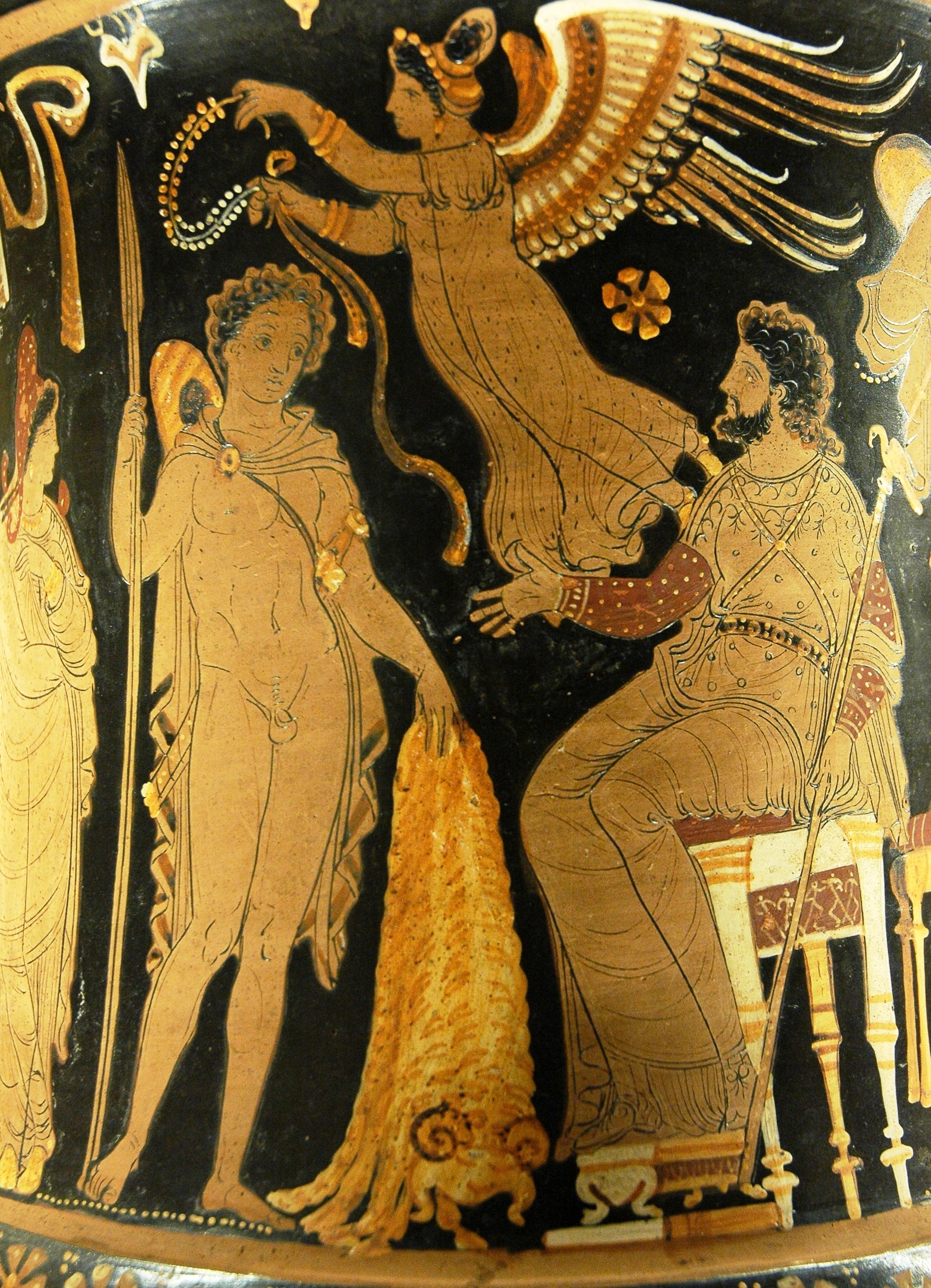|
Hellespont
The Dardanelles (; tr, Çanakkale Boğazı, lit=Strait of Çanakkale, el, Δαρδανέλλια, translit=Dardanéllia), also known as the Strait of Gallipoli from the Gallipoli peninsula or from Classical Antiquity as the Hellespont (; grc-x-classical, Ἑλλήσποντος, translit=Hellēspontos, lit=Sea of Helle), is a narrow, natural strait and internationally significant waterway in northwestern Turkey that forms part of the continental boundary between Asia and Europe and separates Asian Turkey from European Turkey. Together with the Bosporus, the Dardanelles forms the Turkish Straits. One of the world's narrowest straits used for international navigation, the Dardanelles connects the Sea of Marmara with the Aegean and Mediterranean seas while also allowing passage to the Black Sea by extension via the Bosporus. The Dardanelles is long and wide. It has an average depth of with a maximum depth of at its narrowest point abreast the city of Çanakkale. ... [...More Info...] [...Related Items...] OR: [Wikipedia] [Google] [Baidu] |
Dardanus (city)
Dardanus ( gr, Δάρδανος, ''Dardanos'') was an ancient city in the Troad. It was sometimes called Dardania, a term used also for the district around it. Pliny the Elder called it Dardanium. Location At the time of the geographer Strabo, the city of Dardanus stood one mile south of the headland of Dardanis, the point at which the Hellespont, which today is called "the Dardanelles" after the city, begins to narrow. Abydos lay about 70 stadia (13–14 kilometres) to the north and Rhoeteum about the same distance to the south. The acropolis has been identified with the top of Şehitlik Batarya. History The town that Strabo knew was a colony of Aeolians and was distinct from the by then vanished Dardanus or Dardania presented in the Iliad as situated at the foot of Mount Ida and reputed to be named after Dardanus, who founded it earlier than the founding of Ilium. The historical city was one of those that the Achaemenid Empire reduced in 497 BC in the course of its ... [...More Info...] [...Related Items...] OR: [Wikipedia] [Google] [Baidu] |
Helle (mythology)
Helle (; , Héllē), or Ellie, sometimes also called (), was a character in Greek mythology who figured prominently in the story of Jason and the Argonauts. Mythology Phrixus, son of King Athamas of Boeotia and the half-nymph Nephele, along with his twin sister, Helle, were hated by their stepmother, Ino. Ino hatched a devious plot to get rid of the twins, roasting all the town's crop seeds so they would not grow. The local farmers, frightened of famine, asked a nearby oracle for assistance. Ino bribed the men sent to the oracle to lie and tell the others that the oracle required the sacrifice of Phrixus. Before he was killed though, Phrixus and Helle were rescued by a flying golden ram sent by Nephele, their natural mother. Helle fell off the ram into the Hellespont (which was subsequently named after her) and either died or was rescued by Poseidon and turned into a sea-goddess, but Phrixus survived all the way to Colchis, where King Aeetes took him in and treated him kindly, ... [...More Info...] [...Related Items...] OR: [Wikipedia] [Google] [Baidu] |
Troad
The Troad ( or ; el, Τρωάδα, ''Troáda'') or Troas (; grc, Τρῳάς, ''Trōiás'' or , ''Trōïás'') is a historical region in northwestern Anatolia. It corresponds with the Biga Peninsula ( Turkish: ''Biga Yarımadası'') in the Çanakkale province of modern Turkey. Bounded by the Dardanelles to the northwest, by the Aegean Sea to the west and separated from the rest of Anatolia by the massif that forms Mount Ida, the Troad is drained by two main rivers, the Scamander ( Karamenderes) and the Simois, which join at the area containing the ruins of Troy. Mount Ida, called by Homer "many-fountain" (πολυπίδαξ), sourced several rivers, including Rhesos, Heptaporos, Caresus, Rhodios, Granicus (Granikos), Aesepus, Skamandros and Simoeis liad 12.18 ff these rivers were deified as a source of life by the Greeks, who depicted them on their coins as river-gods reclining by a stream and holding a reed. History The Troad gets its name from the Hittites' name ... [...More Info...] [...Related Items...] OR: [Wikipedia] [Google] [Baidu] |
Gallipoli Peninsula From Space
The Gallipoli peninsula (; tr, Gelibolu Yarımadası; grc, Χερσόνησος της Καλλίπολης, ) is located in the southern part of East Thrace, the European part of Turkey, with the Aegean Sea to the west and the Dardanelles strait to the east. Gallipoli is the Italian form of the Greek name (), meaning 'beautiful city', the original name of the modern town of Gelibolu. In antiquity, the peninsula was known as the Thracian Chersonese ( grc, Θρακικὴ Χερσόνησος, ; la, Chersonesus Thracica). The peninsula runs in a south-westerly direction into the Aegean Sea, between the Dardanelles (formerly known as the Hellespont), and the Gulf of Saros (formerly the bay of Melas). In antiquity, it was protected by the Long Wall, a defensive structure built across the narrowest part of the peninsula near the ancient city of Agora. The isthmus traversed by the wall was only 36 stadia in breadthHerodotus, ''The Histories''vi. 36 Xenophon, ibid.; Pseudo-Scyl ... [...More Info...] [...Related Items...] OR: [Wikipedia] [Google] [Baidu] |
Bosporus
The Bosporus Strait (; grc, Βόσπορος ; tr, İstanbul Boğazı 'Istanbul strait', colloquially ''Boğaz'') or Bosphorus Strait is a natural strait and an internationally significant waterway located in Istanbul in northwestern Turkey. It forms part of the continental boundary between Asia and Europe, and divides Turkey by separating Anatolia from Thrace. It is the world's narrowest strait used for international navigation. Most of the shores of the Bosporus Strait, except for the area to the north, are heavily settled, with the city of Istanbul's metropolitan population of 17 million inhabitants extending inland from both banks. The Bosporus Strait and the Dardanelles Strait at the opposite end of the Sea of Marmara are together known as the Turkish Straits. Sections of the shore of the Bosporus in Istanbul have been reinforced with concrete or rubble and those sections of the Strait prone to deposition are periodically dredged. Name The name of the ... [...More Info...] [...Related Items...] OR: [Wikipedia] [Google] [Baidu] |
Gallipoli
The Gallipoli peninsula (; tr, Gelibolu Yarımadası; grc, Χερσόνησος της Καλλίπολης, ) is located in the southern part of East Thrace, the European part of Turkey, with the Aegean Sea to the west and the Dardanelles strait to the east. Gallipoli is the Italian form of the Greek name (), meaning 'beautiful city', the original name of the modern town of Gelibolu. In antiquity, the peninsula was known as the Thracian Chersonese ( grc, Θρακικὴ Χερσόνησος, ; la, Chersonesus Thracica). The peninsula runs in a south-westerly direction into the Aegean Sea, between the Dardanelles (formerly known as the Hellespont), and the Gulf of Saros (formerly the bay of Melas). In antiquity, it was protected by the Long Wall, a defensive structure built across the narrowest part of the peninsula near the ancient city of Agora. The isthmus traversed by the wall was only 36 stadia in breadthHerodotus, ''The Histories''vi. 36 Xenophon, ibid.; Pseudo- ... [...More Info...] [...Related Items...] OR: [Wikipedia] [Google] [Baidu] |
Dardanus (son Of Zeus)
In Greek mythology, Dardanus (; Ancient Greek: Δάρδανος, ''Dardanos'') was the founder of the city of Dardanus at the foot of Mount Ida in the Troad. Family Dardanus was a son of Zeus and the Pleiad Electra, daughter of Atlas but one author claims that his real father was the Corythus, an Italian king. He was the brother of Iasion and sometimes of Harmonia and Emathion. Mythology Dionysius of Halicarnassus (1.61–62) states that Dardanus' original home was in Arcadia, where Dardanus and his elder brother Iasus (elsewhere more commonly called Iasion) reigned as kings following Atlas. Dardanus married Chryse, daughter of Pallas, by whom he fathered two sons: Idaeus and Deimas. When a great flood occurred, the survivors, who were living on mountains that had now become islands, split into two groups: one group remained and took Deimas as king while the other sailed away, eventually settling in the island of Samothrace. There Iasus (Iasion) was slain by Zeus for l ... [...More Info...] [...Related Items...] OR: [Wikipedia] [Google] [Baidu] |
Aegean Sea
The Aegean Sea ; tr, Ege Denizi (Greek: Αιγαίο Πέλαγος: "Egéo Pélagos", Turkish: "Ege Denizi" or "Adalar Denizi") is an elongated embayment of the Mediterranean Sea between Europe and Asia. It is located between the Balkans and Anatolia, and covers an area of some 215,000 square kilometres. In the north, the Aegean is connected to the Marmara Sea and the Black Sea by the straits of the Dardanelles and the Bosphorus. The Aegean Islands are located within the sea and some bound it on its southern periphery, including Crete and Rhodes. The sea reaches a maximum depth of 2,639m to the west of Karpathos. The Thracian Sea and the Sea of Crete are main subdivisions of the Aegean Sea. The Aegean Islands can be divided into several island groups, including the Dodecanese, the Cyclades, the Sporades, the Saronic islands and the North Aegean Islands, as well as Crete and its surrounding islands. The Dodecanese, located to the southeast, includes the islands of R ... [...More Info...] [...Related Items...] OR: [Wikipedia] [Google] [Baidu] |
Golden Fleece
In Greek mythology, the Golden Fleece ( el, Χρυσόμαλλον δέρας, ''Chrysómallon déras'') is the fleece of the golden-woolled,, ''Khrusómallos''. winged ram, Chrysomallos, that rescued Phrixus and brought him to Colchis, where Phrixus then sacrificed it to Zeus. Phrixus gave the fleece to King Aeëtes who kept it in a sacred grove, whence Jason and the Argonauts stole it with the help of Medea, Aeëtes' daughter. The fleece is a symbol of authority and kingship. In the historical account, the hero Jason and his crew of Argonauts set out on a quest for the fleece by order of King Pelias in order to place Jason rightfully on the throne of Iolcus in Thessaly. Through the help of Medea, they acquire the Golden Fleece. The story is of great antiquity and was current in the time of Homer (eighth century BC). It survives in various forms, among which the details vary. Nowadays, the heraldic variations of the Golden Fleece are featured frequently in Georgia, especial ... [...More Info...] [...Related Items...] OR: [Wikipedia] [Google] [Baidu] |
Fixed Crossing
A fixed link or fixed crossing is a persistent, unbroken road or rail connection across water that uses some combination of bridges, tunnels, and causeways and does not involve intermittent connections such as drawbridges or ferries. A bridge–tunnel combination is commonly used for major fixed links. This is a list of proposed and actual transport links between continents and to offshore islands. See also list of bridge–tunnels for another list of fixed links including links across rivers, bays and lakes. History Cosmopolitan Railway In 1890 William Gilpin first proposed to connect the continents by land via the Cosmopolitan Railway. Significant elements of that proposal, such as the English Channel Tunnel, have been constructed since that era. However, the improvement of the global shipping industry and advent of international air travel has reduced the demand for many intercontinental land connections. Trans-Global Highway The Trans-Global Highway is a range of highway s ... [...More Info...] [...Related Items...] OR: [Wikipedia] [Google] [Baidu] |
Greek Language
Greek ( el, label= Modern Greek, Ελληνικά, Elliniká, ; grc, Ἑλληνική, Hellēnikḗ) is an independent branch of the Indo-European family of languages, native to Greece, Cyprus, southern Italy ( Calabria and Salento), southern Albania, and other regions of the Balkans, the Black Sea coast, Asia Minor, and the Eastern Mediterranean. It has the longest documented history of any Indo-European language, spanning at least 3,400 years of written records. Its writing system is the Greek alphabet, which has been used for approximately 2,800 years; previously, Greek was recorded in writing systems such as Linear B and the Cypriot syllabary. The alphabet arose from the Phoenician script and was in turn the basis of the Latin, Cyrillic, Armenian, Coptic, Gothic, and many other writing systems. The Greek language holds a very important place in the history of the Western world. Beginning with the epics of Homer, ancient Greek literature includes many works ... [...More Info...] [...Related Items...] OR: [Wikipedia] [Google] [Baidu] |
Electra (Pleiad)
In Greek mythology, Electra (; 'amber') was one of the Pleiades, the seven daughters of Atlas and Pleione. She lived on the island of Samothrace. She had two sons, Dardanus and Iasion (or Eetion), by Zeus. Pseudo-Scymnos, ''Circuit de la terre'' 646 ff. Electra was connected with the legend of the Palladium, the sacred statue, which became the talismanic protector of Troy. Electra, along with the rest of the Pleiades, were transformed into stars by Zeus. By some accounts, she was the one star among seven of the constellation not easily seen, because, since she could not bear to look upon the destruction of Troy, she hid her eyes, or turned away; or in her grief, she abandoned her sisters and became a comet. Family The Pleiades were said to be the daughters of Atlas, who was the son of the Titan Iapetos. No early source mentions their mother, but according to some late accounts she was the Oceanid Pleione. Hyginus' ''De Astronomica'' says that Electra and her six sisters were ... [...More Info...] [...Related Items...] OR: [Wikipedia] [Google] [Baidu] |

.jpg)






